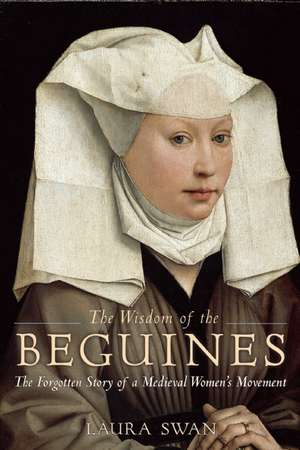The Wisdom of the Beguines: The Forgotten Story of a Medieval Women's Movement
Autor Laura Swanen Limba Engleză Paperback – 13 iun 2016
The beguines began to form in various parts of Europe over eight hundred years ago. Beguines were laywomen, not nuns, and they did not live in monasteries. They practiced a remarkable way of living independently, and they were never a religious order or a formalized movement. But there were common elements that these medieval women shared across Europe, including their visionary spirituality, their unusual business acumen, and their courageous commitment to the poor and sick. Beguines were essentially self-defined, in opposition to the many attempts to control and define them. They lived by themselves or in communities called beguinages, which could be single homes for just a few women or, as in Brugge, Brussels, and Amsterdam, walled-in rows of houses where hundreds of beguines lived together—a village of women within a medieval town or city.
Among the beguines were celebrated spiritual writers and mystics, including Mechthild of Magdeburg, Beatrijs of Nazareth, Hadewijch, and Marguerite Porete—who was condemned as a heretic and burned at the stake in Paris in 1310. She was not the only beguine suspected of heresy, and often politics were the driving force behind such charges.
The beguines, across the centuries, have left us a great legacy. They invite us to listen to their voices, to seek out their wisdom, to discover them anew.
Among the beguines were celebrated spiritual writers and mystics, including Mechthild of Magdeburg, Beatrijs of Nazareth, Hadewijch, and Marguerite Porete—who was condemned as a heretic and burned at the stake in Paris in 1310. She was not the only beguine suspected of heresy, and often politics were the driving force behind such charges.
The beguines, across the centuries, have left us a great legacy. They invite us to listen to their voices, to seek out their wisdom, to discover them anew.
Preț: 75.18 lei
Nou
Puncte Express: 113
Preț estimativ în valută:
14.39€ • 14.97$ • 11.88£
14.39€ • 14.97$ • 11.88£
Carte disponibilă
Livrare economică 24 martie-07 aprilie
Livrare express 08-14 martie pentru 21.19 lei
Preluare comenzi: 021 569.72.76
Specificații
ISBN-13: 9781629190082
ISBN-10: 162919008X
Pagini: 208
Dimensiuni: 140 x 210 x 15 mm
Greutate: 0.27 kg
Editura: BLUEBRIDGE
Colecția Bluebridge
ISBN-10: 162919008X
Pagini: 208
Dimensiuni: 140 x 210 x 15 mm
Greutate: 0.27 kg
Editura: BLUEBRIDGE
Colecția Bluebridge
Cuprins
Introduction
1. Who Were the Beguines?
2. Beguines across Europe
3. The Beguinage
4. Beguine Ministries
5. Beguine Spirituality
6. Beguine Compassion
7. Beguines as Preachers and Performers
8. Literary Beguines
9. Were Beguines Heretics?
Conclusion
Acknowledgments
Notes
Bibliography
Index
1. Who Were the Beguines?
2. Beguines across Europe
3. The Beguinage
4. Beguine Ministries
5. Beguine Spirituality
6. Beguine Compassion
7. Beguines as Preachers and Performers
8. Literary Beguines
9. Were Beguines Heretics?
Conclusion
Acknowledgments
Notes
Bibliography
Index
Recenzii
PRAISE FOR "THE WISDOM OF THE BEGUINES":
“The Wisdom of the Beguines…sweeps up some surprising women…and a range of locales…What’s left is a legacy that had more influence than official church history acknowledges. Swan’s book is a useful corrective.”—THE SEATTLE TIMES
“Swan…brings their lives and writings to the general reader with a clear, admiring narrative…her book is a sympathetic look at the Beguines that will intrigue anyone interested in women’s spirituality.”—PUBLISHERS WEEKLY
“…Swan’s book provides an accessible overview of beguine spirituality in the context of their own times…[it] does a good job of explaining both the beguines’ spiritual practices and their continuing legacy.”—COMMONWEAL
“The Wisdom of the Beguines…sweeps up some surprising women…and a range of locales…What’s left is a legacy that had more influence than official church history acknowledges. Swan’s book is a useful corrective.”—THE SEATTLE TIMES
“Swan…brings their lives and writings to the general reader with a clear, admiring narrative…her book is a sympathetic look at the Beguines that will intrigue anyone interested in women’s spirituality.”—PUBLISHERS WEEKLY
“…Swan’s book provides an accessible overview of beguine spirituality in the context of their own times…[it] does a good job of explaining both the beguines’ spiritual practices and their continuing legacy.”—COMMONWEAL
Notă biografică
Laura Swan has for many years studied and written about the history of women’s spirituality and the monastic life. She is the associate editor of Magistra: A Journal of Women’s Spirituality in History and adjunct professor of religious studies at Saint Martin’s University in Washington State. A member and former prioress of St. Placid Priory, a community of Benedictine women in the Pacific Northwest, her books include The Forgotten Desert Mothers and Engaging Benedict.
Extras
EXCERPT from the INTRODUCTION:
The beguines began to form in various parts of Europe over eight hundred years ago—around the year 1200. Beguines were laywomen, not nuns, and thus did not take solemn vows and did not live in monasteries. The beguines were a phenomenal way of life that swept across Europe, yet they were never a religious order or a formalized movement. And they did not have one specific founder or rule to live by. But there were common elements that rendered these women distinctive and familiar, including their common way of life, chastity and simplicity, their unusual business acumen, and their commitment to God and to the poor and marginalized. These women were essentially self-defined, in opposition to the many attempts to control and define them. They lived by themselves or together in so-called beguinages, which could be single houses for as few as a handful of beguines or, as in Brugge, walled-in rows of houses enclosing a central court with a chapel where over a thousand beguines might live—a village of women within a medieval town or city. And each region of Europe has its own beguine stories to tell.
Some beguines were suspected of heresy, and often politics
were the driving force behind such charges. Certain clerics
defended beguines against charges of heresy, while other women
had to go undercover by joining a Benedictine or Cistercian
monastery.
[...]
Beguines existed all the way into the twenty-first century—
news agencies reported the death of the “last beguine,” Marcella
Pattyn, in 2013. She was in her early nineties and had lived in
Belgium. However, there are reports of young women making
spiritual promises and seeking a beguine lifestyle, both in Europe
and North America. Some of these new beguines live with their
parents, or by themselves, and others have created informal communities.
[...]
Scholars have identified 111 medieval beguinages
in Belgium alone, and thirteen of them are UNESCO World
Heritage sites: Ghent, Leuven, Diest, and Brugge; Hoogstraten,
Lier (Lierre), Mechelen (Malines), and Turnhout; Sint-Truiden
(Saint-Trond), Tongeren (Tongres), Dendermonde (Termonde),
Sint-Amandsberg (Mont-Saint-Amand-lez-Gand), and Kortrijk
(Courtrai). Today most homes within the surviving beguinages
in the Low Countries are affordable housing for the elderly, writers,
or artists. The exteriors and gardens are kept as they might
have been when beguines—the original builders—lived there.
Most of these beguinages will have one home, furnished appropriately
for the medieval period, open for visitors to explore and
learn about the beguines and their way of life.
The beguines began to form in various parts of Europe over eight hundred years ago—around the year 1200. Beguines were laywomen, not nuns, and thus did not take solemn vows and did not live in monasteries. The beguines were a phenomenal way of life that swept across Europe, yet they were never a religious order or a formalized movement. And they did not have one specific founder or rule to live by. But there were common elements that rendered these women distinctive and familiar, including their common way of life, chastity and simplicity, their unusual business acumen, and their commitment to God and to the poor and marginalized. These women were essentially self-defined, in opposition to the many attempts to control and define them. They lived by themselves or together in so-called beguinages, which could be single houses for as few as a handful of beguines or, as in Brugge, walled-in rows of houses enclosing a central court with a chapel where over a thousand beguines might live—a village of women within a medieval town or city. And each region of Europe has its own beguine stories to tell.
Some beguines were suspected of heresy, and often politics
were the driving force behind such charges. Certain clerics
defended beguines against charges of heresy, while other women
had to go undercover by joining a Benedictine or Cistercian
monastery.
[...]
Beguines existed all the way into the twenty-first century—
news agencies reported the death of the “last beguine,” Marcella
Pattyn, in 2013. She was in her early nineties and had lived in
Belgium. However, there are reports of young women making
spiritual promises and seeking a beguine lifestyle, both in Europe
and North America. Some of these new beguines live with their
parents, or by themselves, and others have created informal communities.
[...]
Scholars have identified 111 medieval beguinages
in Belgium alone, and thirteen of them are UNESCO World
Heritage sites: Ghent, Leuven, Diest, and Brugge; Hoogstraten,
Lier (Lierre), Mechelen (Malines), and Turnhout; Sint-Truiden
(Saint-Trond), Tongeren (Tongres), Dendermonde (Termonde),
Sint-Amandsberg (Mont-Saint-Amand-lez-Gand), and Kortrijk
(Courtrai). Today most homes within the surviving beguinages
in the Low Countries are affordable housing for the elderly, writers,
or artists. The exteriors and gardens are kept as they might
have been when beguines—the original builders—lived there.
Most of these beguinages will have one home, furnished appropriately
for the medieval period, open for visitors to explore and
learn about the beguines and their way of life.












